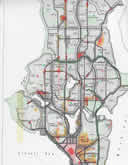





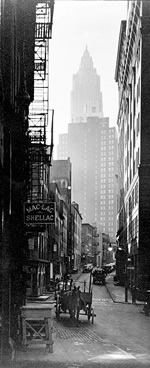
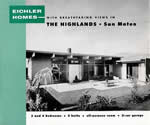
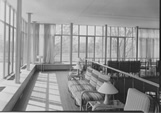
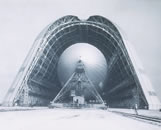
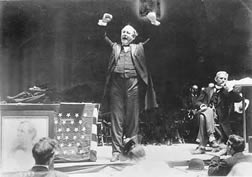
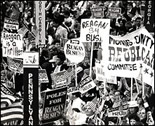
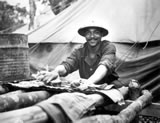
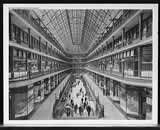
Here are links to some favorite online destinations. If you know of a site that you think is worth adding to this list, please tell me about it. American history and politics The 1930s and 1940s in Color. Remarkable collection of color photographs from the Great Depression and World War II made available as part of the Library of Congress' photo stream on Flickr, a site that is host to a growing number of outstanding archival photographs from American museums and libraries. The Living Room Candidate: Presidential Campaign Commercials, 1952-2004. Complete archive of television commercials from every major-party candidate from Ike to Barack. Online exhibition from the American Museum of the Moving Image. Shorpy. A vintage photography blog featuring thousands of high-definition images from the 1850s to 1950s. New photographs added nearly every day. Two sources for all things presidential: American President, based at the Miller Center of Public Affairs at the University of Virginia, which contains refereed online resources on American Presidents and the Presidency, from the founding to the present; and The American Presidency Project at UCSB, an online archive of over 80,000 documents related to the American Presidency. American cities, past and present Urban Planning, 1794-1918. A searchable anthology of primary documents discussing city planning in the United States and Europe, compiled by Prof. John Reps. Hypercities. Created by an interdisciplinary team of collaborators from UCLA and USC, this is a digital research and education platform for exploring, learning about, and interacting with the layered histories of cities and global spaces. Pictures of American Cities. Photographs from the holdings of the National Archive and Records Administration. Two glimpses into America's urban past from the Library of Congress: The Life of a City: Early Films of New York, 1898-1906 and Before and After the Great Earthquake and Fire: Early Films of San Francisco, 1897-1906. The Mannahatta Project. Historical visualization project of the Wildlife Conservation Society that explores the original ecology of Manhattan. Uncover pre-European Manhattan Island, block by block. Robert Moses and the Modern City. Online accompaniment to 2007 exhibition about greater New York City's master builder at the Queens Museum. Invincible Cities. The extraordinary photographs of Camilo Jose Vergara, documenting thirty years of changing landscapes in poor, minority communities in the urban United States. Enter the World of Eichler Design. Beautifully designed site about the modernist merchant builder, created by a former and current Eichler homeowner. Exploring the West. A project of the Bill Lane Center for the American West at Stanford University, this is a high-school curriculum committed to expanding and enriching students’ perceptions of the region. Includes a module on metropolitan growth in the West. Metropolitan Policy Program at the Brookings Institution. Research and commentary on land use, regional governance, transportation, education, and housing in American cities and suburbs. Trulia Hindsight. Utterly addictive site featuring interactive maps of American urban properties through time. Metropolitan Institute at Virginia Tech. Research institute devoted to metropolitan growth and governance in the US and elsewhere. The Urban History Association. The professional association for urban historians. Features links to many other online archival materials about American cities. H-Urban. A moderated, multi-disciplinary forum for discussion and dissemination of scholarship on urban history and urban studies. Features teaching center with syllabi, primary resources, and other tools for teaching about cities and suburbs. Sidney N. Gamble Collection of Photographs of China, 1908-1932. Online archive at Duke University of 5,000 photographs of early twentieth century China, including major cities. China from Above. Photographer George Steinmetz takes flight to capture early twenty-first century China, including its exploding cities and suburban subdivisions. Globalization and World Cities (Loughborough University, UK). Interdisciplinary web resource featuring research briefs and other publications, data sets on world cities, and original research projects. European Urban Knowledge Network. Fifteen EU member countries participate in this collaborative forum for research and practice. Urban Age. Independent research institute addressing urban sustainability in the world's megacities. Worldmapper. The world as you've never seen it before - world maps, with territories resized according to the subject of interest. AHR Conversation on Transnational History. Roundtable discussion from December 2006 featuring six leading historians addressing the opportunities presented by transnational approaches. (Proprietary database; requires university ID.) Human and Natural Environments The Urban Environment Group at Yale University. The research site of my collaborator Prof. Karen C. Seto, including descriptions and visualizations of current research on urbanization and environmental change in China, India, Vietnam, Qatar, and the United States. Urbanization and Global Environmental Change (UGEC). A core project of the International Human Dimensions Programme of Global Environmental Change, featuring original research and resources on urbanization and environmental indicators worldwide. Poverty & the Environment. This 2006 special series from Grist magazine considers the intersection of economic and ecological survival includes historical essays, investigative reports, statistical data on poverty and environmental justice, and virtual walking tours of high-poverty areas in the United States. Knowing Where to Stand. Online exhibition of photography and mediations on the meaning and history of landscape by Anne Whiston Spirn. Silicon Valley Archives (Stanford University). The world's greatest repository of materials related to the history and development of Silicon Valley. Also see Silicon Genesis, an oral history of the semiconductor industry, including interviews with early leaders of Fairchild Semiconductor, Intel, and more. Beyond Markets and Hierarchies: Toward a New Synthesis of American Business History, by Naomi R. Lamoreaux, Daniel M. G. Raff, and Peter Temin, American Historical Review 108:2 (April 2003). Outlines a new approach to business history that incorporates and helps explain the origins of the knowledge economy. (Proprietary database; requires university ID.) OECD Guide to Measuring the Information Society. Data and standards for measuring growth of internet and related technologies worldwide, and their social impact. Board on Science, Technology, and Economic Policy of the National Academies. Access to full text of major reports relating to innovation and technology-driven economies in the US and abroad. Rising Above the Gathering Storm: Energizing and Employing America for a Brighter Economic Future. Why increased public investment in higher education and research is absolutely essential. The Bill Lane Center for the American West at Stanford University, exploring the past, present, and future of North America west of the Mississippi. Spatial History Project at the Bill Lane Center. Research group of scholars working on projects at the intersection of history and geography using Geographic Information Systems (GIS). Governing America in a Global Era (GAGE) Program. Research initiative based at the Miller Center of Public Affairs at the University of Virginia. Includes links to public lectures, syllabi, publications about American political development and world affairs. History News Network (HNN). Putting today's headlines in a historical context, featuring articles and other commentary by leading political historians. The Edge of the American West. Opinion, rumination, edification about the state of the world and the state of the profession. Rustbelt Intellectual. Live from Philadelphia, commentary about cities, politics, and culture. Why Study History? Prof. Peter N. Stearns explains it all to you. Learning to do Historical Research. A basic introduction to historical research for anyone and everyone who is interested in studying the past, from Prof. William Cronon of the University of Wisconsin. Reading, Writing, and Researching for History: A Guide for College Students. Step-by-step aids to developing and writing an outstanding college research paper, from Prof. Patrick Rael of Bowdoin College. The Uses and Abuses of Powerpoint, compiled by Prof. Scott Campbell of the University of Michigan. History Matters (George Washington University). The most comprehensive compilation of primary documents, reviewed and annotated web sites, and tools for teaching American History. Gilder Lehrman Institute of American History. Robust web site includes online exhibitions of digitized primary source materials, links to other online resources for historians, bibliographies, and tools for teaching college-level and K-12 history. Exploring the West. Online curriculum designed for high school teachers and students of the North American West, containing modules on urban growth, maps, cowboys, and more. How to Give a Lecture. The prize-winning Stanford historian David M. Kennedy explains how it's done. Directory of History Journals. Database of scholarly journals of history, compiled by the American Historical Association. Resources for History Graduate Students. Links to advice on grant writing, the job market, and more from Prof. Jennifer Sessions of the University of Iowa.
|